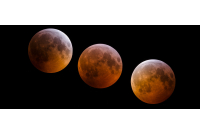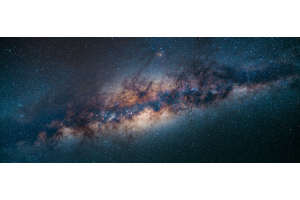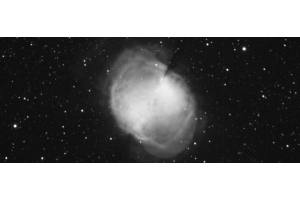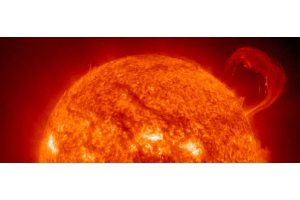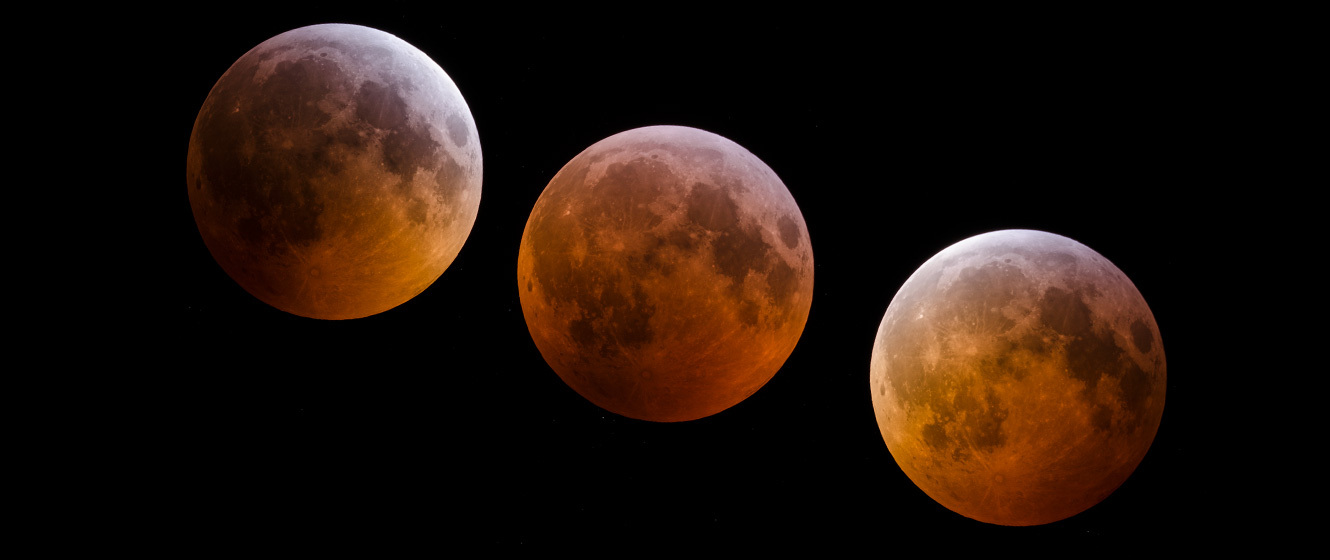
While not a great year for the major meteor showers, 2021 promises its fair share of lunar and planetary encounters. Whether you’re a morning or evening observer, you’ll have plenty of opportunities to see Mercury and Venus, Mars will pass by the Pleiades and both Jupiter and Saturn are at their best during the warm summer nights. As an added bonus, we have two lunar eclipses to look forward to this year.
NOTE: While these events have been compiled with North American observers in mind, the majority can also be seen throughout the rest of the world. Check an astronomical app, magazine or other online resource for more specific information relating to your location.
JANUARY
January 3rd, Quadrantid Meteor Shower
Conditions aren’t the best for the first meteor shower of the year, but they could be worse. With the Moon in its waning gibbous phase, it won’t rise until late evening, and unfortunately, will be high above the horizon by the early hours of the morning. That’s when the meteors are usually at their best, so you might find the fainter shooting stars are drowned out by moonlight. With the Moon rising in the east, the meteors will appear to come from a point to the lower left of the Big Dipper’s handle, toward the northeast. However, they are usually quite bright so you should still be able to spot a few.
January 10th, Conjunction of Mercury, Jupiter and Saturn
This is a sight you won’t want to miss, as this is literally a once-in-a-lifetime opportunity to see the three planets so close together. They’ll be close from the 8th, to the 12th, but the 10th is when they’ll be at their best. That said, this will be a challenging sight, to say the least. You’ll need a completely clear and unobstructed view of the southwestern horizon and, most likely, binoculars to see all three. At fifteen minutes after sunset, you might be able to catch Jupiter, the brightest of the three, at about eight degrees above the horizon. Mercury appears to its lower left, while Saturn, the faintest, will be to its lower right.
January 11th, Waning Crescent Moon and Venus
Venus is gradually edging closer to the Sun in the morning sky but should remain visible for the remainder of the month. The waning crescent Moon will appear to its right in the predawn twilight this morning.
January 14th, Waxing Crescent Moon, Mercury and Jupiter
If you missed Mercury on the 10th, you’ll have another chance tonight, as the two day old Moon appears to its upper left. If you imagine the thin crescent as a bow with an invisible arrow, the arrow will point in the general direction of Mercury. You might also see Jupiter to the lower right of Mercury. Saturn is also above the horizon, to the lower right of Jupiter, but it’s very low and will be very difficult to see in the bright twilight sky.
January 20th, First Quarter Moon and Mars
After being at its best in October, Mars is still a fairly bright and prominent object in the evening sky. You’ll find the first quarter, or half Moon, to its lower right tonight.
January 23rd, Mercury at Greatest Eastern Elongation
Mercury is now at its furthest distance from the Sun in the sky and, theoretically, should be relatively easy to see. Take a look toward the southwest at about 15 minutes after sunset. The tiny planet can be seen as a pinkish-white star, some 10 degrees above the horizon.
January 28th, Full Moon
This month’s full moon is also known as the Wolf Moon, a name possibly derived from Native American folklore. You’ll find it among the faint stars of Cancer, the Crab, about midway between Castor and Pollux, the twin stars of Gemini, and Regulus, the brightest star in the constellation of Leo, the Lion.
FEBRUARY
February 18th, First Quarter Moon and Mars
The Moon has come around to visit Mars once more, and once again it’s in its first quarter, or half Moon, phase. It appears just to the left of the red planet in the evening sky tonight.
February 23rd, Conjunction of Mercury and Saturn
Mercury and Saturn are both low over the east-southeastern horizon this morning. If you look about half an hour before sunrise, they’ll appear level with one another, about seven degrees above the horizon. You’ll need a clear, unobstructed view, and using binoculars will definitely help the search.
February 26th/27th, Full Moon
February’s full moon is known as the Snow Moon because the second month of the year is typically the coldest and most prone to snow in the northern hemisphere. It turns full in the early hours of the 27th, making the evening of the 26th the best time to catch it when it’s closest to being 100% illuminated. You’ll find it among the stars of Leo, the Lion, with the bright star Regulus a little to its right.

Credit: Istvan Mihaly
MARCH
March 3rd, Conjunction of Mars and the Pleiades Star Cluster
Last year, in early April, Venus passed just slightly south of the Pleiades star cluster and made for a fine binocular sight for three days straight. This year, we’re treated to a similar event with Mars, but since Mars moves more slowly, this close encounter will last longer. The red planet has slowly been catching up to the Pleiades since the last week of February, but it’s on the evening of the 3rd and 4th of March that it’ll be closest to the cluster. Definitely a high point of the year, be sure to wait until about two hours after sunset and then look to the west to spot coppery-orange Mars. The planet won’t be as close to the Pleiades as Venus was last year, but it will still make for a breathtaking sight.
March 5th, Conjunction of Mercury and Jupiter
Mercury is now at its furthest from the Sun in the sky, and there’s a good chance to see it close to Jupiter in the predawn twilight this morning. Look toward the southeast at about 20 minutes before sunrise; the pair will be low, about 8 degrees above the horizon, but Jupiter should be apparent. Mercury will be very close by, slightly to Jupiter’s left, with less than a full Moon’s width between them.
March 10th, Waning Crescent Moon, Mercury, Jupiter and Saturn
You’ve now got an excellent opportunity to see the crescent Moon close to three planets in the predawn sky. Look toward the southeast at about thirty minutes before sunrise, and you should see Jupiter about eight degrees above the horizon. Saturn appears some way to its upper right, while Mercury may be glimpsed to its lower left. A crescent Moon will be at about the same altitude as Mercury, and to the lower right of Jupiter.
March 28th, Full Moon
This month’s full moon is called the Worm Moon. Why? It’s usually about this time of year that you’ll start to see worms emerging from the soil underfoot. Meanwhile, in the skies above, the Moon will be emerging over the eastern horizon shortly after sunset. It’s among the faint stars of Virgo, but you should still be able to see the bright star Spica some way below it.
APRIL
April 6th, Waning Crescent Moon and Saturn
The Moon has come around again to visit with Jupiter and Saturn in the predawn sky. You’ll find them above the southeastern horizon about 30 minutes before sunrise. The Moon will appear below Saturn, with Jupiter shining to the right. Come back tomorrow morning to see the Moon below Jupiter instead.
April 16th, Waxing Crescent Moon and Mars
After turning new on the 12th, the crescent Moon now appears below Mars in the evening sky, with both planet and Moon in the constellation of Taurus. You’ll find the red planet above the Moon, while some way below it will be Aldebaran, the orange-red star that marks the eye of the bull. Compare the colors and brightness of Mars and the star. Which appears brighter and more colorful to your eye?
April 22nd, Lyrid Meteor Shower
The Lyrid meteor shower reaches its peak in the early hours of the 23rd, but you can catch a few shooting stars in the evening hours of the 22nd. Unfortunately, the Moon is a waxing gibbous and its light will brighten the sky and drown out the fainter shooting stars. Under more ideal conditions, you could expect to see a maximum of about 18 meteors an hour, but even with the Moon’s interference, it’s still worth taking a look.
April 26th, Full Moon
It’s a “pink” moon this month, but don’t expect the color to change at all. It’s called a Pink Moon because the creeping phlox wildflower blooms at this time of year. It’s also a Super Moon, which means it’s closer to the Earth than usual and appears slightly bigger as a result - about 8% bigger, to be precise. That being said, you probably won’t notice a difference. Another thing you probably won’t notice are the stars of Libra, the constellation through which the Moon is currently passing. All those stars are too faint to be seen in the moonlight, but look for bright, coppery Antares some way to its left.
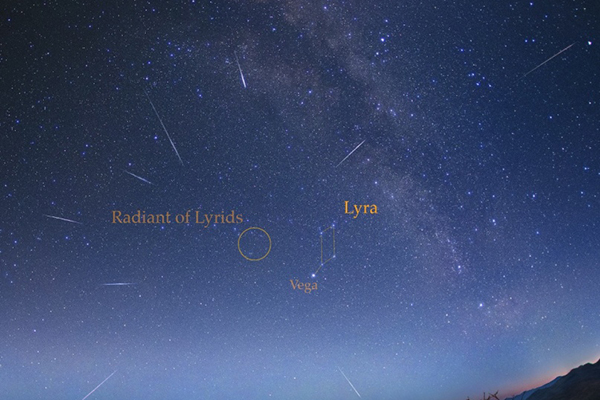
Credit: Yuri Beletsky
MAY
May 4th, Last Quarter Moon, Jupiter and Saturn
Rise early this morning to see the last quarter Moon between Jupiter and Saturn in the morning twilight. Saturn will appear to the upper right of the Moon, whereas Jupiter will be to the upper left. Come back tomorrow morning to see the Moon to the lower left of the planet.
May 5th/6th, Eta Aquariid Meteor Shower
Best seen from the southern hemisphere, under ideal conditions the Eta Aquarids can theoretically produce up to 70 shooting stars an hour. Unfortunately, although you can see a few meteors in the evening, they’re typically best seen just a few hours before the dawn, as the sky begins to brighten. This year, the waning crescent Moon will also be visible, but shouldn’t cause too much interference.
May 13th, Waxing Crescent Moon and Mercury
The Moon turns new on the 11th and then appears close to Mercury in the evening sky. This is a good opportunity to see the innermost planet, as it will appear just a little to the right of the two day old Moon. Start looking toward the west-northwest at about 15 minutes after sunset. The Moon and Mercury will be about 16 degrees above the horizon. Venus may also be glimpsed, barely above the horizon, but unless you have a totally unobstructed view, you probably won’t be able to spot it.
May 15th, Waxing Crescent Moon and Mars
Now it’s Mars’ turn to be visited by the crescent Moon, with the red planet just to the upper left of the Moon. You’ll find them both toward the west-northwest after sunset and beneath the twin stars of Castor and Pollux in Gemini.
May 16th, Mercury at Greatest Eastern Elongation
Mercury reaches its greatest distance from the Sun in the sky today. It’s now 23 degrees away from the Sun, making it a relatively easy target. It won’t set until about two hours after the Sun, giving you plenty of time to find it in the evening twilight. As on the 13th, it appears as a pinkish-white star, some 16 degrees above the west-northwestern horizon from about 15 minutes after sunset.
May 25th/26th, Full Moon and Total Lunar Eclipse
April brings us the second of our two Super Moons for the year, and this one is the closer of the two. Called the Flower Moon, as the flowers are now in bloom, this year brings the added bonus of a total lunar eclipse. Unfortunately, it starts just a few hours before the dawn of the 26th, making it impossible for North American observers to witness the entire eclipse. However, those on the west coast will have the opportunity to enjoy at least the first half.
The table shows the times on the 26th for each stage of the eclipse.
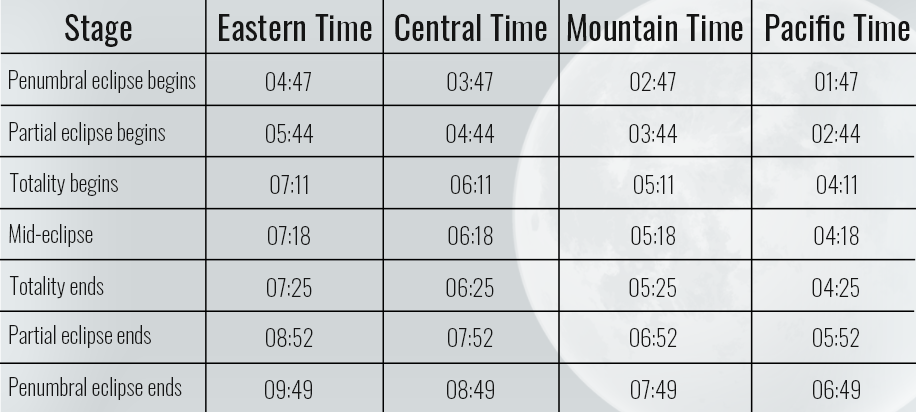
May 28th, Conjunction of Mercury and Venus
If you’ve been keeping your eye on Mercury over the past ten days, you’ll have seen it dropping toward the horizon after sunset. Meanwhile, Venus has been slowly edging away from the Sun and into the evening twilight. Tonight the two form a close conjunction, but it’ll be tricky to spot. If you want to try your luck, look toward the west-northwest at about 15 or 20 minutes after sunset. At that time, the pair will be about ten degrees above the horizon.
May 31st, Waning Gibbous Moon and Saturn
The Moon makes its second visit of the month to Saturn this morning. You’ll find it to the lower left of the planet and over the southern horizon an hour before sunrise. It’ll be below Jupiter at the same time tomorrow morning.

Credit: Jean van der Meulen
JUNE
June 1st, Waning Gibbous Moon and Jupiter
Yesterday the waning gibbous Moon appeared to the lower left of Saturn, but this morning it appears almost directly below Jupiter. The pair rise nearly four and a half hours before the Sun, giving you plenty of time to observe them both. Alternatively, go outside just thirty minutes to an hour before sunrise to enjoy the view in the predawn twilight.
June 11th, Waxing Crescent Moon and Venus
If you haven’t seen Venus yet in the evening sky, you might get your chance tonight. A very slender crescent Moon will appear to the lower right of the planet in the evening twilight. Look for the pair about 15 or 20 minutes after sunset, toward the west-northwest.
June 24th, Full Moon
June brings us the Strawberry Full Moon, so-called because it marks the start of the short strawberry harvest season. You’ll find it among the stars of Sagittarius, close to the most southerly point along the ecliptic. As a result, it won’t rise very high above the horizon from the northern hemisphere.
June 27th, Waning Gibbous Moon and Saturn
Look outside at about two hours before sunrise and you’ll see the waning gibbous Moon directly below Saturn over the southern horizon. Tomorrow it will appear to the right of Jupiter, while on the 29th it will appear to the left of the giant planet.
JULY
July 4th, Mercury at Greatest Western Elongation
Mercury now appears at its best in the predawn twilight, but will be somewhat tricky to spot. If you’re up to the challenge, look towards the east at about a half hour before sunrise. If you’ve got a clear, unobstructed view of the horizon, you could see the tiny planet about nine degrees above the horizon. Good luck!
July 7th, Waning Crescent Moon and Mercury
No luck finding Mercury on the 4th? Try again this morning, as the waning crescent Moon will appear to its upper right in the predawn twilight. Mercury will be about half the altitude of the Moon, but could be a little brighter and easier to see than it was three days ago. Alternatively, try again on the 8th, when the very slender Moon will appear just to the left of Mercury, potentially making it easier to see.
July 11th, Waxing Crescent Moon, Venus and Mars
One of the astronomical highlights of 2021, you can now catch the crescent Moon in the evening sky close to Venus and Mars. The Moon will appear some way to the right of the planetary pair over the western horizon. As for Mars and Venus themselves, they’re now very close together, with brilliant Venus just to the right of faint Mars. They’ll draw closer over the next few nights.
July 12th, Waxing Crescent Moon, Venus and Mars
The gap between Venus and Mars has now halved, with just a full Moon’s width between them. Mars appears just slightly to the lower left of Venus, while the crescent Moon is now some way to the upper left of the pair. Again, you’ll find them over the western horizon after sunset. Tomorrow, at the same time, the gap will be about the same but Mars will then appear directly below Venus. Well worth a look with binoculars or a telescope with low magnification!
July 23rd, Full Moon and Saturn
The full Moon this month is known as a Buck Moon, as this is the time of year when new antlers begin to emerge on a young buck’s head. You’ll find Saturn a little way to the Moon’s left this evening, with both planet and Moon appearing against the background stars of Capricornus.
July 25th/26th, Waning Gibbous Moon and Jupiter
If you’re up late on the 25th, you might catch the waning gibbous Moon rising above the southeastern horizon at around 11pm. Just above it is golden Jupiter, while Saturn continues to shine to the right of the pair. Both planets will be at their best and brightest next month.

Credit: Gustavo Ackles
AUGUST
August 2nd, Saturn is at Opposition
Saturn becomes the first planet to reach opposition this year, beating Jupiter by just 18 days. Opposition means the planet is directly opposite the Sun in the sky, so as a result, it rises at sunset, is due south at around 1 a.m., and then sets when the Sun comes up. This is also when the planet is closest to the Earth during the year, so the planet will appear at its brightest and also will be at its best when observed telescopically.
August 10th, Waxing Crescent Moon and Venus
Mars is now all but lost within the evening twilight, but Venus continues to shine above the western horizon. Look out for a slender, one day old Moon to its right this evening. You should be able to easily spot the pair from about fifteen minutes after sunset.
August 12th/13th, Perseid Meteor Shower
The Perseids are one of the best and most reliable meteor showers. Every year, on the evening of the 12th and in the early hours of the 13th, stargazers look to the heavens and, under ideal conditions, can expect to see anything up to 100 shooting stars an hour. This year, with the waxing crescent Moon barely brightening the sky, you have an excellent opportunity to enjoy the shower at its best. Stay up late - or get up early - and be sure to make the most of these summer fireworks!
August 20th, Waxing Gibbous Moon and Saturn
You’ll find a nearly full Moon just to the lower left of Saturn tonight. The pair will be rising at sunset over the southeastern horizon and will be due south at about thirty minutes past midnight. The Moon will jump forward to Jupiter tomorrow night.
August 20th, Jupiter is at Opposition
There’s a second celestial event for the 20th, as Jupiter reaches opposition tonight. It’s slowly moving through the northeastern corner of Capricornus, and as with Saturn on the 2nd, the planet now appears at its biggest and brightest. This makes it the ideal time to observe it telescopically. If you’ve never seen the Great Red Spot, this could be your chance!
August 22nd, Full Moon
August’s full Moon is known as the Sturgeon Moon, due to the number of sturgeon you’ll find in the lakes and rivers at this time of year. This month the full Moon is passing through the faint stars of Aquarius, the Water Bearer, with Jupiter and Saturn to its right.
SEPTEMBER
September 8th, Waxing Crescent Moon and Mercury
Mercury is back in the evening sky and will be at its best on the 13th. In the meantime, if you want a challenge, try searching for it in the twilight shortly after sunset tonight. There’s a thin, day old Moon towards the west and Mercury appears as a faint, pinkish-white star to its lower left. You’ll most likely need binoculars to see it, as it will only be six degrees above the horizon at 15 minutes after sunset.
September 9th, Waxing Crescent Moon and Venus
Here’s an easier sight for you. You should have no problem finding Venus in the evening twilight, as it will shine for at least an hour after sunset towards the south-southwest. The waxing crescent Moon, now a little thicker, appears to it’s right. Venus is about 14 degrees above the horizon at 15 minutes after sunset.
September 13th, Mercury at Greatest Eastern Elongation
Mercury has now reached its greatest distance from the Sun in the sky, but unfortunately, it won’t be easy to spot. It’s still only about six degrees above the west-southwestern horizon 15 minutes after sunset, making it necessary to have a clear, unobstructed view to spot it. Again, using binoculars will also help.
September 14th, Neptune is at Opposition
Neptune, our solar system’s most distant planet, is now at opposition and can be found hidden among the stars of Aquarius, the Water Bearer. At magnitude 7.8, it’s possible to spot the planet with binoculars, but you’ll need a telescope to see anything more of it. A magnification of about 150x will show a tiny, blue disc, quite unlike any of the stars that surround it.
September 16th, Waxing Gibbous Moon and Saturn
A waxing gibbous Moon accompanies Saturn across the evening sky tonight. The Moon will appear below the planet, with Jupiter some way to their left. The Moon jumps over to Jupiter tomorrow night, where it will appear to the lower right of the giant planet.
September 20th, Full Moon
September and October are special months when it comes to the name of the full Moon, as whichever full Moon occurs closest to the autumnal equinox is called the Harvest Moon. This year, the honor belongs to September. Of course, it’s called the Harvest Moon as it gives farmers the extra light they need to gather the harvest in the evening. This month, the Moon can be found among the stars of Pisces, the Fishes.
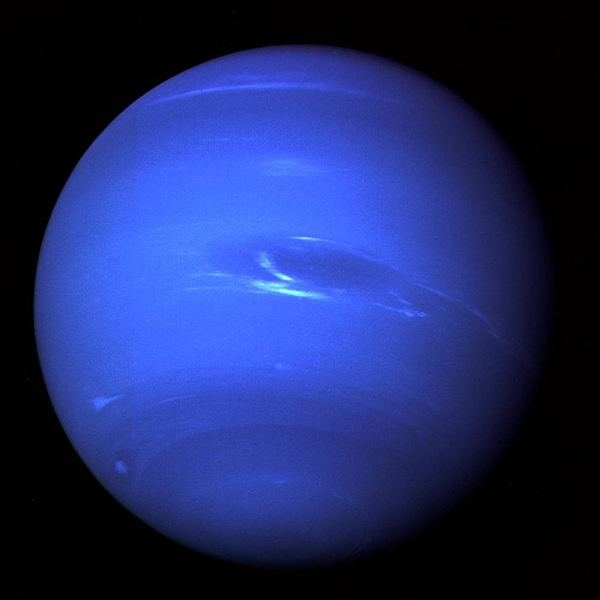
Credit: NASA/JPL-Caltech
OCTOBER
October 9th, Waxing Crescent Moon and Venus
The Moon returns to Venus in the evening twilight tonight. You’ll find them both over the southwestern horizon, with the Moon appearing to the upper left of the planet. Can you see a coppery star to the left of the pair? That’s Antares, the red supergiant star that marks the beating heart of Scorpius, the Scorpion.
October 13th, First Quarter Moon and Saturn
The Moon reaches first quarter today and appears half illuminated in the evening sky. You’ll find Saturn above the Moon, while Jupiter patiently waits his turn toward the east. If you live in North America, you’ll have the opportunity to see the Moon close to Jupiter twice this month. It happens first on the 14th, when the Moon is to the lower right of the planet. The following night, on the 15th, you’ll find the Moon has passed the planet and now appears to its left.
October 20th, Full Moon
October’s full Moon is known as the Hunter’s Moon, as it coincides with hunting season. This month the Moon is passing through the constellation of Cetus, the Whale. While not a true constellation of the zodiac, the Sun, Moon and planets will sometimes skim the constellation as they pass from Pisces to Aries.
October 21st/22nd, Orionid Meteor Shower
The Orionid meteor shower reaches its maximum in the early hours of the 22nd, but if you’re unable to stay up late, you can almost certainly catch a few shooting stars in the evening of the 21st. Under ideal conditions, you can expect to see up to 20 an hour, but with the Moon just past full, you’ll most likely see less. Fortunately, the Orionids are known to be quite bright and you shouldn’t be disappointed.
October 25th, Mercury at Greatest Western Elongation
If you’re an early riser, this is your last chance to spot Mercury in the predawn twilight. While there are no other planets nearby to act as a marker, and the Moon is setting in the west, Mercury should still be relatively easy to spot. Rising about an hour and a half before the Sun, it will be 13 degrees above the horizon at 20 minutes before sunrise and should appear as a bright, pinkish-white star.
October 29th, Venus at Greatest Eastern Elongation
Finally, after five months of slowly creeping further away from the Sun in the sky, Venus has now reached its best visibility in the evening twilight. Like Mercury in the morning sky, there’s no Moon or other bright planets nearby, but Venus is unmissable. It sets nearly two and a half hours after the Sun and appears as an unmistakable, brilliant white star in the southwest after sunset. It’ll stay visible for another two months but will be gone by the beginning of 2022.

NOVEMBER
November 3rd, Waning Crescent Moon and Mercury
There’s a great opportunity to see the crescent Moon above Mercury in the predawn twilight this morning. You’ll need an unobstructed view of the east-southeastern horizon, but if you look outside at about 30 minutes before sunrise and you should easily see the pair about eight degrees above the horizon. Mars is just a little way below them both, but it’s still too close to the Sun and too faint to be seen.
November 4th, Uranus is at Opposition
If you’ve never seen the seventh planet, now’s the perfect time. It’s at opposition today, which, of course, means it’s ideally placed for observation throughout the night. If you’re an experienced astronomer with excellent eyes and dark skies, you may even be able to spot the planet with just your eyes. Otherwise, you’ll definitely need binoculars to spot the aquamarine planet. Telescopically, a magnification of 50x or more is required to see the planet as a disc.
November 7th, Waxing Crescent Moon and Venus
After passing Mercury in the morning sky on the 3rd, it now appears close to Venus in the evening sky. By this time, the Moon will be about three days old, making a very attractive sight for anyone who sees the pair close together in the darkening twilight sky. If you have binoculars, be sure to take a closer look as both worlds will appear within the same field of view.
November 10th, First Quarter Moon and Saturn
The Moon reaches first quarter tomorrow night and will appear to the lower left of Jupiter. Tonight, however, it’s to the left of Saturn, right in the heart of Capricornus, the Sea Goat. Can you identify any of the constellation’s stars against the indigo of the falling night?
November 18th/19th, Leonid Meteor Shower
Another reliable meteor shower, under ideal conditions the Leonids can be expected to produce about 20 meteors an hour. Unfortunately, as with several other showers this year, the light of the nearly full Moon will brighten the sky, causing the fainter meteors to fade from view. It is, however, one of the brighter showers, and you should at least be able to see a shooting star or two.
November 18th/19th, Full Moon and Partial Lunar Eclipse
November brings us the second of two lunar eclipses for the year. While May’s eclipse was total and not visible for its entirety from North America, November’s is partial and visible from more locations within the continent. In fact, with 97% of the Moon’s surface in the Earth’s shadow, it’s almost a total eclipse in itself. Known as the Frost Moon, if you live in an area with snowfall, it should make for a stunning sight.
The table shows the times for each stage of the eclipse. For some locations in North America the eclipse will begin late in the evening of the 18th and finish in the early hours of the 19th.
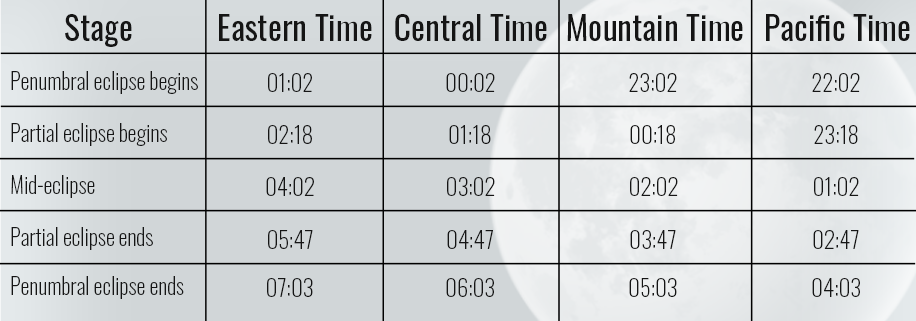
DECEMBER
December 6th, Waxing Crescent Moon and Venus
The Moon and Venus come together for their last close encounter of the year tonight. At two days old, the Moon should show an appreciable crescent, with the pair once again fitting within the same binocular field of view. Look for them over the southwestern horizon after sunset.
December 7th, Waxing Crescent Moon and Saturn
Both Saturn and Jupiter are sinking toward the Sun in the sky and the gap between these two planets and Venus is quickly closing. Go outside tonight and you’ll see that Saturn is roughly midway between Venus and Jupiter and is the faintest of the three planets. You’ll also see a shining crescent Moon below the ringed planet, making for a very attractive sight. Once again, come back tomorrow for a last look at the Moon below Jupiter.
December 13th/14th, Geminid Meteor Shower
The Geminid meteor shower is one of the few showers that can be easily seen and appreciated in the relatively early hours of the evening. The constellation of Gemini rises about three hours after sunset and will be well above the eastern horizon by 10pm. Under normal circumstance, this gives observers the perfect opportunity to spot some shooting stars before midnight, but once again, this year the Moon might interfere. It’s still about five days from being full, but its light may be sufficiently bright to drown out the fainter meteors. Under ideal conditions, you could see up to 120 shooting stars an hour - how many will you see tonight?
December 18th, Full Moon
December’s full Moon is appropriately known as the Cold or Yule Moon. It’s on the easternmost edge of Taurus, the Bull, close to the border with Gemini, the Twins. Winter has some bright stars and constellations, not least of which being Orion the Hunter and the aforementioned Bull and Twins. Which of those constellation’s bright stars can you see in the moonlight?
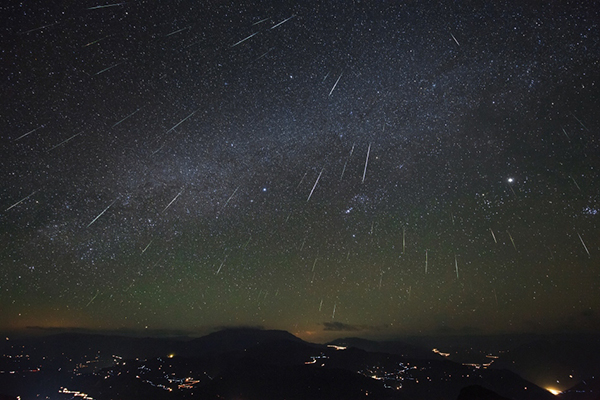
Credit: Jeff Dai
December 26th, Conjunction of Mercury and Venus
Here’s a challenge for you. Do you have a clear, unobstructed view of the southwestern horizon? Can you still easily see Venus in the evening twilight? Go outside tonight, at about 15 minutes after sunset, and look for that planet in the darkening sky. If you’re lucky, you might spot a pinkish-white star directly below Venus, about halfway between the planet and the horizon. This is Mercury, and it’s currently edging away from the Sun and into the evening twilight. If you can’t see it with just your eyes, turn your binoculars toward Venus and make sure the planet is at the edge of your field of view, in the 12 o’clock position. At the bottom, near the edge of your field of view, is Mercury. Happy hunting!
December 30th, Conjunction of Mercury and Venus
No luck finding Mercury on the 26th? Try again tonight. It’s moved further away from the Sun, while Venus has edged a little closer. As a result, Mercury now appears slightly higher in the sky and, conversely, Venus is now a little lower. It also means Mercury is more easily seen; you’ll find it to the left of Venus tonight, at about the same altitude as its sister planet. Again, both planets will fit within the same binocular field of view.
December 31st, Waning Crescent Moon and Mars
Here’s your last lunar and planetary encounter for the year. While Mercury is moving into the evening sky, Mars is now becoming more easily seen in the predawn sky. This morning you’ll find a waning crescent Moon to its upper right, while the bright, coppery star Antares appears to the lower right of the pair. You should be able to see all three above the southeastern horizon at about 45 minutes before sunrise.
Free Printable Astronomical 2021 Calendar PDF
Note: This is a large file and may take a moment to load. If you are unable to print the PDF from your browser, we suggest opening it in a PDF program.
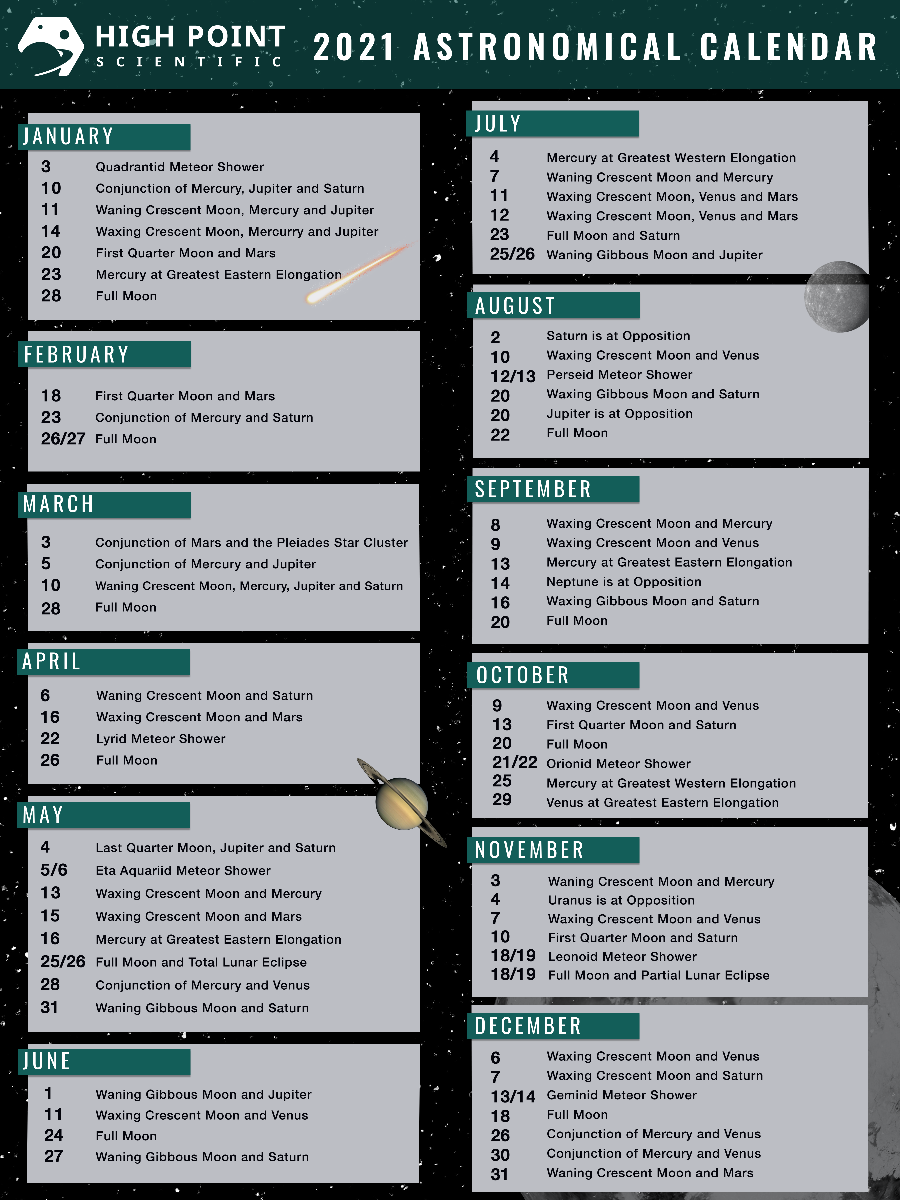
This Article was Last Updated on 08/14/2023

